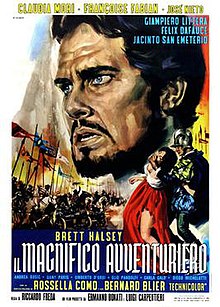| The Magnificent Adventurer | |
|---|---|
 | |
| Directed by | Riccardo Freda |
| Screenplay by | Filippo Sanjust |
| Story by |
|
| Produced by | |
| Starring | |
| Cinematography |
|
| Edited by | Ornella Micheli |
| Music by | Francesco De Masi |
| Production companies |
|
| Distributed by | Regional |
| Release date |
|
| Countries |
|
| Box office | ₤121 million |
The Magnificent Adventurer (Italian: Il magnifico avventuriero) is a 1963 adventure film directed by Riccardo Freda. It is loosely based on real life events of Benvenuto Cellini.
Plot
| This article needs a plot summary. Please add one in your own words. (June 2016) (Learn how and when to remove this message) |
Cast
- Brett Halsey as Benvenuto Cellini
- Françoise Fabian as Lucrezia
- Claudia Mori as Piera
- Bernard Blier as Papa Clemente VII
- Rossella Como as Angela
- Félix Dafauce as conte Frangipani
- José Nieto as Connestabile di Borbone
- Jacinto San Emeterio as Francisco I
- Elio Pandolfi as attore
- Andrea Bosic as Michelangelo
- Diego Michelotti as Carlo V
- Umberto D'Orsi as granduca di Toscana
- Carla Calò as zia di Angela
- Sandro Dori as zio di Angela
- Giampiero Littera as Francesco
- Dany París as moglie di Francesco
Production
The Magnificent Adventurer was director Riccardo Freda's last film for Panda Cinematografica. It was based on the real-life character of Benvenuto Cellini, a sculptor, goldsmith, draftsman, soldier and musician. A memoir of his life gained huge popularity during the 19th century which became the inspiration for other famous writers such as Alexandre Dumas. Freda was fascinated by Cellini, declaring him Cellini has "always been a model of independence for me. However, he was more of a great brigand than a great artist." The script does follow Cellini's memoirs, and places him in an imaginary scenario.
The Magnificent Adventurer was shot under the title Le avventure di Benvenuto Cellini between March and April 1963 in Rome at Castle Sant'Angelo, Castle d'Ostia, and at the De Paolis Studios.
Release
The Magnificent Adventurer was released in Italy on August 3, 1963 where it was distributed by Regional. It grossed 121 million lire in Italy which film historian and critic Roberto Curti described as "nondescript". The film was released as Laventurier magnifigue (L'Aigle de Florence) and was purchased by American International Pictures for distribution to television as The Magnificent Adventurer. It was also released under the title The Burning of Rome.
Reception
A contemporary review in the Monthly Film Bulletin described the film as "more serious and sober than much of Freda's other recent work, and his admirers may be a little disappointed at the often lethargic and lackluster result, which is quite inferior to the very similar Seventh Sword for instance."
Richard Roud referred to the film as "a constant pleasure to the eye" and "a glittering riot of delicate colour shadings in both sets and costumes".
References
Footnotes
- ^ Curti 2017, p. 320.
- Roberto Poppi, Mario Pecorari (2007). Dizionario del cinema italiano. I film. Gremese Editore, 2007. ISBN 978-8884405036.
- Paolo Mereghetti. Il Mereghetti - Dizionario dei film. B.C. Dalai Editore, 2010. ISBN 8860736269.
- ^ Curti 2017, p. 201.
- ^ Curti 2017, p. 202.
- ^ Curti 2017, p. 203.
- Curti 2017, p. 204.
- "Magnifico Avventuriero, Il". Monthly Film Bulletin. Vol. 31, no. 360. British Film Institute. 1964. p. 135. ISSN 0027-0407.
- Richard Roud (1980). Cinema: a critical dictionary : the major film-makers, Volume 1. Viking Press, 1980. ISBN 0670222577.
Sources
- Curti, Roberto (2017). Riccardo Freda: The Life and Works of a Born Filmmaker. McFarland. ISBN 978-1476628387.
External links
| Benvenuto Cellini | |
|---|---|
| Sculptures |
|
| Portrayals |
|
| Related | |
This article related to an Italian film of the 1960s is a stub. You can help Misplaced Pages by expanding it. |
This article related to a French film of the 1960s is a stub. You can help Misplaced Pages by expanding it. |
- 1963 films
- 1960s historical adventure films
- French historical adventure films
- Italian historical adventure films
- Spanish historical adventure films
- Films directed by Riccardo Freda
- Films scored by Francesco De Masi
- Films set in Rome
- Films set in the 16th century
- Biographical films about artists
- Cultural depictions of Michelangelo
- Cultural depictions of Francis I of France
- Cultural depictions of Charles V, Holy Roman Emperor
- Cultural depictions of Pope Clement VII
- Cultural depictions of Benvenuto Cellini
- Biographical films about sculptors
- 1960s French films
- 1960s Italian films
- 1960s Italian film stubs
- 1960s French film stubs